Intro to Animal Science Exam 2
1/160
Earn XP
Description and Tags
Reproduction, Lactation, Meat Science, and Beef Industry
Name | Mastery | Learn | Test | Matching | Spaced |
|---|
No study sessions yet.
161 Terms
reproductive tracts
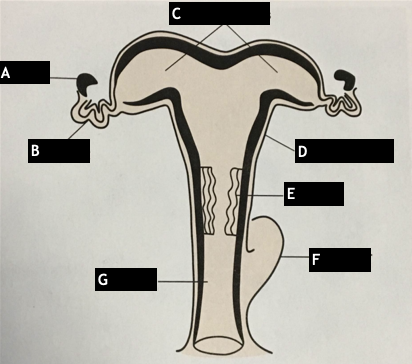
label the different parts of a female reproductive tract (uterus)
A. Ovary
B. Oviduct
C. Uterine Horns
D. Uterine Body
E. Cervix
F. Bladder
G. Vagina
What happens in the Ovary
Production of oocytes (immature female eggs)
Production of estrogen and progesterone
What happens in the Infundibulum & where is it located
Transports ova from ovary to the oviduct
Located in between ovary and oviduct
What happens in the Oviduct?
the site of fertilization & early development
transports ova and sperm
What happens in the Uterine Horns
Assists in sperm transport
Regulation of the Corpus Luteum
Site of implantation and pregnancy
what happens in the cervix?
Facilitates sperm transport (in sows and mares)
prevents uterine contamination
what happens in the vagina?
a copulatory organ
the birth canal
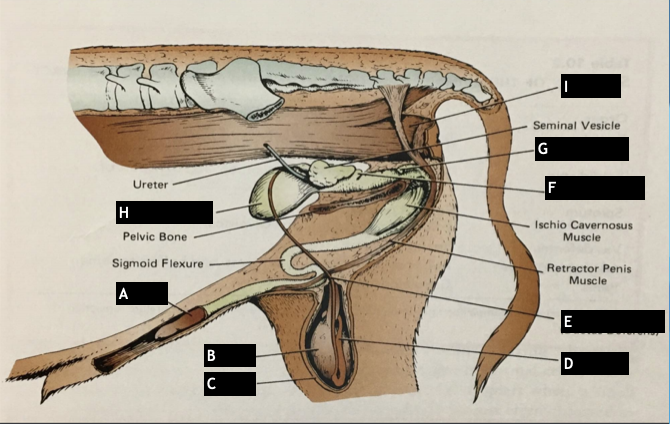
label the different parts of the male reproductive tract
A. Penis
B. Testis
C. Scrotum
D. Epididymis
E. Vas Deferens
F. Prostate Gland
G. Cowper’s Gland
H. Urinary Bladder
I. Rectum
what happens in the tesis (testicles)?
Testosterone production (leydig cells)
Spermatoza production (seminiferous tubules)
what happens in the epididymis?
a long and tightly coiled tube
high concentration of sperm that is stored, matured, and transported
what happens in the vas deferens?
transports mature sperm to the urethra
what are the important accessory glands to know?
seminal vessicles
prostate
cowper’s gland
what are seminal vessicles
fluid contains fructose, prostaglandin, and proteins
this makes the repro tract contract to move sperm
what is prostate
the fluid produced to enhance the sperm motility
what is the cowper’s gland
it produces a lubricating fluid that neutralizes the acidity of urine in males and females during copulation (sex)
what is the scrotum
provides support for the testicles
what is the penis
a copulatory organ
what are accessory glands
they add fluid volume, nutrients, and buffers to semen
they are secreted into the urethra
which animals have the heaviest pair of testes?
Swine (Boar)
Cattle (Bull)
Sheep (Ram)
which animals have the highest sperm concentration?
Turkey: 8,000 - 30,000
Sheep & Goat: 2,000 - 3,000
Chicken: 3,000 - 7,000
Cattle: 800 - 2,000
Which animals have the highest amount os sperm per ejaculation?
Swine: 30-60 bil
Cattle/Horse: 5-15 bil
Turkey: 1-20 bil
Sheep: 2-4 bil
what are the hormones involved in ovarian function
Gonadotropin releasing hormone (GnRH)
Estrogen
Progesterone
FSH
LH
what are the hormones involved in testicular function
Gonadotropic Hormones
Luteinizing hormone (LH)
Follicle stimulating hormone (FSH)
Testosterone
What does the gonadotropin-releasing hormone (GnRH) do
Produced in: Hypothalamus
Targets: Anterior Pituitary
Function: Stimulates the release of LH and FSH
what does the luteinizing hormone (LH) do
Produced in: Anterior Pituitary
Targets:
Female: Ovary (luteal cells)
Male: Testis (leydig cells)
Function:
Female: Stimulates ovulation, CL formation, and progesterone production
Male: stimulates testosterone production
what does the follicle stimulating hormone (FSH) do?
Produced in: Anterior Pituitary
Targets:
Female: Ovary (grandulose cells)
Male: Testis (seritoli cells)
Function:
Female: stimulates development of follicle
Male: stimulates sperm production
what does the prolactin hormone do?
Produced in: Anterior Pituitary
Targets: mammary tissue
Function: stimulates milk synthesis and maternal behavior
what does the oxytocin hormone do?
Produced in: Posterior Pituitary
Targets:
uterus
mammary tissue
Function:
Uterus: stimulates gamete transport and uterine contraction
Mammary tissue: stimulates milk let down
what does the estrogen hormone do?
Produced in: Follicle and Placenta
Targets:
uterus
hypothalamus
mammary tissue
Function:
stimulates mating behavior
promotes GnRH release
stimulates uterine growth
stimulates secondary sex characteristics
what does the progesterone hormone do?
Produced in: Corpus luteum (CL) and Placenta
Targets:
uterus
mammary tissue
hypothalamus
Function:
Maintains pregnancy
mammary development
inhibits GnRH release
what does the testosterone hormone do
Produced in: leydig cells of testes
Targets: skeletal muscle, seminiferous tubules, repro tract
Function:
stimulates anabolic grown
sperm production
secondary sex characteristics
what does the prostaglandin F2a hormone do
Produced in: endometrium of the uterus
Targets: uterus (myometrium) and graafian follicles
Function:
released if pregnancy doesn’t occur
stimulates the regression of CL and ovulation
uterine contraction
what does the placental lactogen hormone do
Produced in: placenta
Targets: mammary gland
Function: promotes lactation
what does the relaxin hormone do
Produced in: ovary and placenta
Targets: cervix and pelvis
Function: stimulates cervical dilation and pelvic expansion
what does the cortisol (fetal) hormone do
Produced in: adrenal glands of the fetus
Targets: dam’s uterus
Function: stimulates the initiation of parturition (birth)
what does the melatonin hormone do?
Produced in: pineal gland
Targets: hypothalamus
Function: partially controls seasonal reproductive pattern
outilne testicular function through hormones
LH & FSH are produced in the anterior pituitary gland
LH stimulates the production of testosterone in leydig cells
FSH stimulates the development of sperm in seminiferous tubules
outline ovarian function through hormones
the hypothalamus releases GnRH in the presence of estrogen and when progesterone is low
GnRH activates LH and FSH which increase the cyclic activity
these hormones control the estrous cycle (a period)
what is estrous vs. estrus
estrous: referring to the cycle
estrus: referring to the heat displayed by animals
what are the 3 types of cycles
polyestrous
seasonally polyestrous
monoestrous
what are polyestrous animals
multiple cycles throughout the year
ex) cattle and swine
what are seasonally polyestrous animals
multiple cycles during a certain time of the year
ex) sheep, goats, horses
what are monoestrous animals
one cycle per year
ex) dogs
what animals have the longest estrous cycles
Horse (22)
Cattle (21)
Sheep (17)
what animals have the longest duration of estrus?
Horse (7 days)
Swine (60 hrs)
Goat (39 hrs)
Sheep (30 hrs)
which animals begin puberty at the youngest age
Goat (4-8)
Swine (5-10)
Sheep (6-12)
Cattle (6-18)
explain the estrous cycle
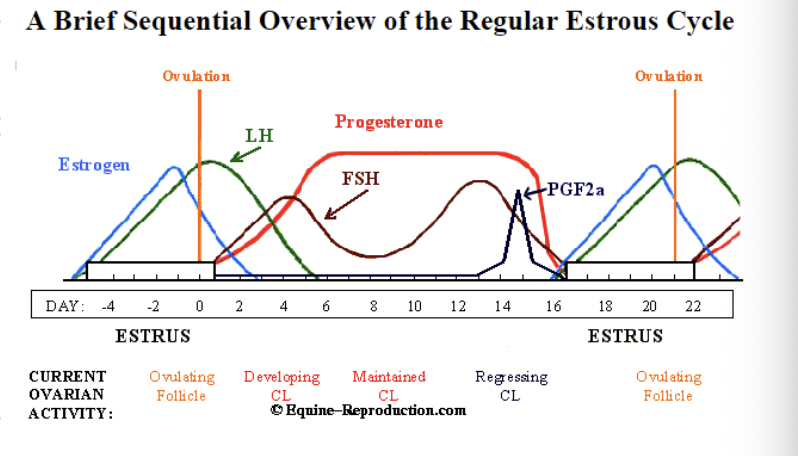
explain the process of fertilization
explain the pre-attachment embryo development
embryonic cells duplicate their genes and divide every 20 hours
the embryo migrates through to oviduct to the uterus in 3-4 days
maternal recognition of pregnancy signals the presence of the embryo and allows the attachment to the uterus
explain the process of pregnancy
the placenta produces hormones that maintain pregnancy, stimulate the mammary glands, and enhance fetal growth
Attachment of placentation/chorion takes many days
this is critical for embryonic survival
what does the placenta do
its a temporary organ that facilitates metabolic connections between the dam and the fetus
How many days does it take for attachment of placentation in cows, mares, and ewes?
cows: 20-30 days
mares: 36-38 days
ewes: 13-14 days
what are the 4 different types of attachment of chorion (the fetal component of the placenta)
diffuse: uniformly cover the chorion in mares and sows
cotyledonary: series of structures called placentomes in ewes, cows and does
zonary: congregates to a specific band or zone in dogs and cats
discoid: 1 or 2 distinct disc-like structures in primates and rats
what animals have the longest gestation lengths
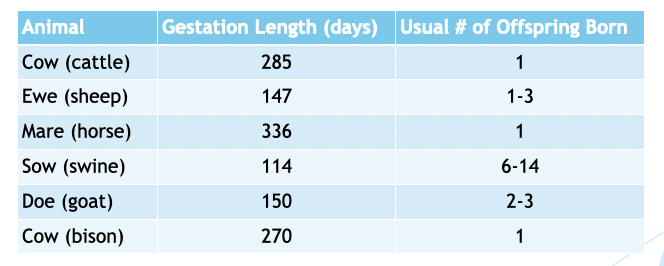
what are the 5 positions of parturition
normal presentation: “diving” position with front legs in front of head
breech; the butt of the sheep is the first part of the body facing exterior
upside down and backwards: the lamb is in a breech position but flipped upside down
head back: head is tilted backwards with front legs in front of head
backwards: lamb is facing legs first and head to the back to the uterus
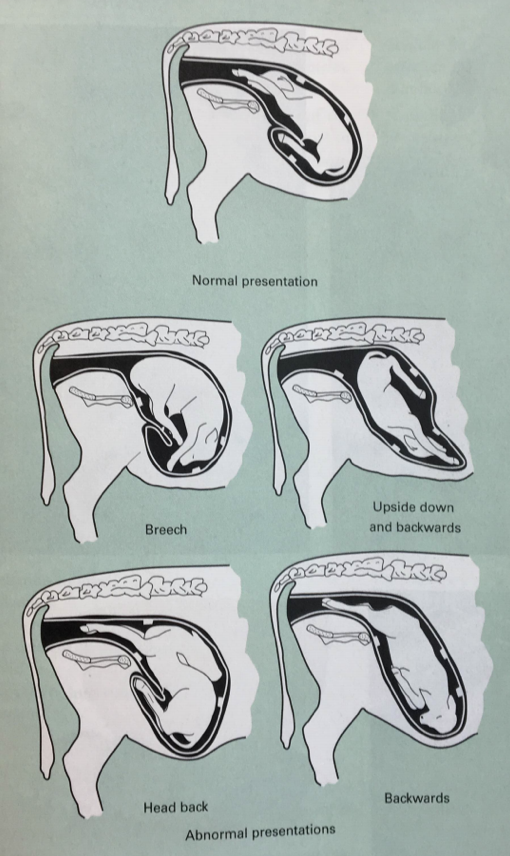
lactation
what are the important structures of the mammary gland
alveoli: where milk collects and gains constituents
exocrine gland: produces external secretion of milk through a series of ducts
what are 2 functions of milk
provides nutrients
a source of passive immunity from mother to offspring
what are the alveoli
the secretory tissue of the mammary gland
milk travels through the ducts to a gland cistern during milk letdown
what is the structure of a cow’s mammary glands
4 separate mammary glands terminating into 4 teats
1 canal/cistern per teat
what is the structure of a horse’s mammary glands
4 mammary glands terminate into 2 teats
2 canals/cisterns per teat
what is the structure of a goat/ewe’s mammary glands
2 mammary glands terminate into 1 teat
1 canal/cistern per teat
what is the structure of a sow’s mammary glands
6-20 mammary glands terminate into 1 teat
2 canals/cisterns per teat
typically only 10-14 mammary glands are functional
what hormones are responsible for lactation and how
growth hormones, addrenal corticoids, and prolactin
estrogen and progesterone levels decrease
oxytocin is released by suckling which initiates milk let down
what influences the maintenance of lactation
hormones like prolactin, thyroid hormones, adrenal hormones, and growth hormones
what hormones are involved in the development/growth of mammary glands
estrogen: for duct and cistern growth
progesterone: for the growth of the alveoli
placental lactogen: for general cell growth of mammary gland
what factors affect milk production
genetics
feed and management (routine feeding/milking schedules)
health (mastitis = inflammation of the udder)
gender of the offspring (males need more milk)
number of offspring (twins/triplets produce more milk than those with singles)
age of female
which animals have the highest solids and fats in their milk
reindeer
water buffalo
sow
ewe
which animals have the most protein in their milk
reindeer
ewe & sow
water buffalo
which animals have the most lactose in their milk
humans
mares
sow
what is the milk composition for a hooded seal
60% fat
feeds pups only 4 days
pups are born on ice
what is the milk composition for black rhinos
0.2% fat
nurse for 2 years
what is the milk composition for tammar wallabies
14% sugar
can produce 2 different milks for joeys of different ages
what is the milk composition for eastern cottontails
15% protein
leave young for long periods
what are immunoglobins (ig)
they are involved in the passive immunity transfer from mother to offspring and are gained through colostrum in large/domestic livestock
what is colostrum
the first milk
how does consuming colostrum help passive immunity transfer
the igs in colostrum give the newborn protection from microorganisms
the intestinal wall of newborns has pores so colostrum antibodies are absorbed
the wall becomes less porous afte 24 hours which allows less absorption of antibodies
this is why the immunity of the newborn is dependent on consuming colostrum within the first few hours of birth
meat science
what red meats and poultry meats do we mainly look at
Red meats:
beef
pork
lamb
Poultry:
chicken
turkey
what is the etymology for the meat of a calf
veal
what is meat mostly classified as
skeletal muscle
what is meat science
the study of the unique characteristics of muscle and other animal tissues as they are transformed into meat
what does finish mean in meat head terms
the fat on in animal that is deposited in the final months before harvest
what does carcass mean in meat head terms
the primary product of animal slaughter
what does wholesale cut mean in meat head terms
cuts into which the carcasses are cut according to industry defined standards
ex: rib, round, chuck, loin
what does primal cut mean in meat head terms
a wholesale cut trimmed to specific dimensions
what does finish retail cut in meat head terms
cuts prepared for sale in a retail market
ex) ribeye steak, round roast, arm roast
what are the types of proteins in meat
sarcoplasmic proteins: water soluble proteins
myofibrilar proteins: salt soluble proteins
stromal proteins: connective tissue
what is myoglobin
the primary pigment responsible for meat color
contains a heme group (Fe)
explain how myoglobin plays a role in meat color
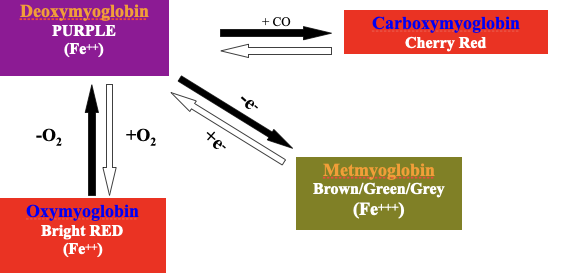
what are some things that meat tenderness are affected by
animal age
post mortem age
quality grade
genetics
muscle
animal nutrition
what are the reasons for meat processing
allow us to use the whole animal
preserve meat for longer
more convenient products
good source of inexpensive protein
prevent food borne illnesses
what is added to meats to cure them
Nitrite
why is nitrite added to processed meats
color development
flavor development
prevents spoilage
controls growth of botulism
food safety
what are the top 5 food borne illnesses
norovirus
campylobacter
salmonella
clostridium perfringens
e. coli
which pathogens contribute to the most deaths
salmonela
campylobacter
norovirus
listeria monocytogens
e. coli
explain the norovirus
what: stomach flu or food poisoning
contamination from: food workers in food service
symptoms: nausea, vomiting, diarrhea, cramps, fever, etc
onset after exposure: 12-48 hours
duration: 12-60 hours
explain hepatitis A
contamination from: food service
symptoms: jaundice, anorexia, diarrhea, vomiting, flu-like symptoms
patients shed viral bacteria for weeks before and after illness
onset after exposure: 15-50 days
duration: 12-60 hours